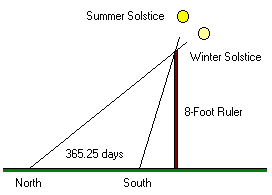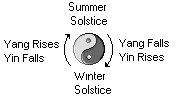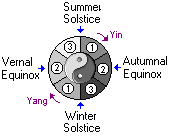The Origin of 12 Chinese Zodiac Signs - Earthly Branches

Ancient China was an agricultural society. Most Chinese were farmers. They needed a calendar to tell them when to sow, to cultivate, to reap and to store the crop.
They learned the calendar simply to upright a post on the ground to trace the shadow of the post. From the shadow, they know the four directions, four seasons, the length of the year, Summer Solstice, Winter Solstice, Vernal Equinox, Autumnal Equinox and so on.
The most basic and important factor in the shadow is Yin Yang. The energy of Yang in the air is called Yang Chi and the energy of Yin in the air is called Yin Chi.

Night time is getting longer and daylight is getting shorter from Summer Solstice to Winter Solstice. That means Yang Chi begins to decline and Yin Chi begins to grow from Summer Solstice till Winter Solstice.
Yang Chi and Yin Chi are even on Vernal Equinox; Yin passes the duty to Yang at this time. Yang Chi and Yin Chi are even on Autumnal Equinox, Yang leaves the duty to Yin at this time.

Base on the grow and decline relationship of Yin Yang, Chinese divided a year into three Yang periods and three Yin periods. The first Yang is cold; the second Yang is windy; the third Yang is hot; the first Yin is fire; the second Yin is wet and the third Yin is dry. These
They used one to stand for the sky, which is Yang and
used two to stand for the ground, which is Yin. Therefore Yang has its
symbol ![]() and Yin has its symbol
and Yin has its symbol ![]() .
Later on Chinese divided a year into six Yang periods and six Yin
periods.
.
Later on Chinese divided a year into six Yang periods and six Yin
periods.
Six Yang periods are ![]() ,
, ![]() ,
,
![]() ,
, ![]() ,
,
![]() and
and ![]() .
The symbols tell that Yang Chi is rising. Six Yin periods are
.
The symbols tell that Yang Chi is rising. Six Yin periods are ![]() ,
,
![]() ,
, ![]() ,
,
![]() ,
, ![]() and
and ![]() . All these symbols are part of the
I-Ching. The symbol, a series of six liens, is called Hexagram in I-Ching. When using
for calendar symbols, these hexagrams carry the weather
information.
. All these symbols are part of the
I-Ching. The symbol, a series of six liens, is called Hexagram in I-Ching. When using
for calendar symbols, these hexagrams carry the weather
information.
Applying six Yin and Yang periods on the the life cycle of plant, Chinese developed 12 Chinese pictographic characters as another counting system in the following. These 12 characters were borrowed to the Chinese calendar. Chinese call them 12 Branches.
| Sequence | Chinese Characters | Chinese PictographicCharacters | Hexagram |
|---|---|---|---|
| 1 |  Zi |
 (son)
Yang Chi begins to grow inside the ground. The seed begins to absorb water and
grow too. (son)
Yang Chi begins to grow inside the ground. The seed begins to absorb water and
grow too. |
 |
| 2 |  Chou |
 (twister) Yin Chi bends down into the ground. The spout of the seed twisters
out in the ground.
(twister) Yin Chi bends down into the ground. The spout of the seed twisters
out in the ground. |
 |
| 3 |  Yin |
 (develop) Yang Chi grows up from the ground. Plant all come out together
from the cold soil.
(develop) Yang Chi grows up from the ground. Plant all come out together
from the cold soil. |
 |
| 4 |  Mao |
 (up) Sun rises. Planet begin to spout the new leaf mixing with Yang Chi
and Yin Chi.
(up) Sun rises. Planet begin to spout the new leaf mixing with Yang Chi
and Yin Chi. |
 |
| 5 |  Chen |
 (stretch) Yang Chi grows half way. Plant continue to shake, stretch out
and group.
(stretch) Yang Chi grows half way. Plant continue to shake, stretch out
and group. |
 |
| 6 |  Si |
 (done) Yin Chi is going to die and Yang Chi is full energy. Plant grow
faster and full with leaves. Animal begin to move south.
(done) Yin Chi is going to die and Yang Chi is full energy. Plant grow
faster and full with leaves. Animal begin to move south. |
 |
| 7 |  Wu |
 (fight)
Yang Chi totally overwhelms Ying Chi. But Yin Chi begins to reborn, grow
back from the ground. Plant
grow completely. (fight)
Yang Chi totally overwhelms Ying Chi. But Yin Chi begins to reborn, grow
back from the ground. Plant
grow completely. |
 |
| 8 |  Wei |
 (taste)
Yang Chi begins to decrease the energy. Plant won't grow again and fruit
on the Plant are getting tasty. (taste)
Yang Chi begins to decrease the energy. Plant won't grow again and fruit
on the Plant are getting tasty. |
 |
| 9 |  Shen |
 (body) Ying Chi begins to take over the Yang Chi. Plant completely form
their body and fruit are ready to harvest.
(body) Ying Chi begins to take over the Yang Chi. Plant completely form
their body and fruit are ready to harvest. |
 |
| 10 |  You |
 (harvest) Plant succeed the duty and are getting old. Yang Chi looks for a
place to hide.
(harvest) Plant succeed the duty and are getting old. Yang Chi looks for a
place to hide. |
 |
| 11 |  Xu |
 (destroy)
Yin Chi takes over Yang Chi. Planet begin to wither. (destroy)
Yin Chi takes over Yang Chi. Planet begin to wither.
|

|
| 12 |  Hai |
 (seed)
Yang Chi completely hide inside the seed. (seed)
Yang Chi completely hide inside the seed.
|

|
First, Chinese use Ten Stems and Twelve Branches together as the cycle of 60 counting system for days. The counting system is call ![]() Heavenly Stem Earthly Branch. Nobody knows when Chinese started using this
counting system. Between the
Heavenly Stem Earthly Branch. Nobody knows when Chinese started using this
counting system. Between the ![]() Chin and
Chin and ![]() Han
dynasties, around 206 B.C., Chinese applied Twelve Branches
on the names of months. Later, the Animal names were connected with the Branch
name of Months.
Han
dynasties, around 206 B.C., Chinese applied Twelve Branches
on the names of months. Later, the Animal names were connected with the Branch
name of Months.
| Sequence | Branch | Animal | Name | Yin or Yang |
|---|---|---|---|---|
| 1 |  |
  |
Rat | Yang |
| 2 |  |
  |
Cow | Yin |
| 3 |  |
  |
Tiger | Yang |
| 4 |  |
  |
Rabbit | Yin |
| 5 |  |
  |
Dragon | Yang |
| 6 |  |
  |
Snake | Yin |
| 7 |  |
  |
Horse | Yang |
| 8 |  |
  |
Sheep | Yin |
| 9 |  |
  |
Money | Yang |
| 10 |  |
  |
Chicken | Yin |
| 11 |  |
  |
Dog | Yang |
| 12 |  |
  |
Pig | Yin |
Today, not too many Chinese remember the formal names of the branches. Therefore people like to use animal names instead. The other problem is many people still cannot memorize the sequence.
Chinese animal names are all pictographic characters. They are from the shape of animal or the face of the animal.